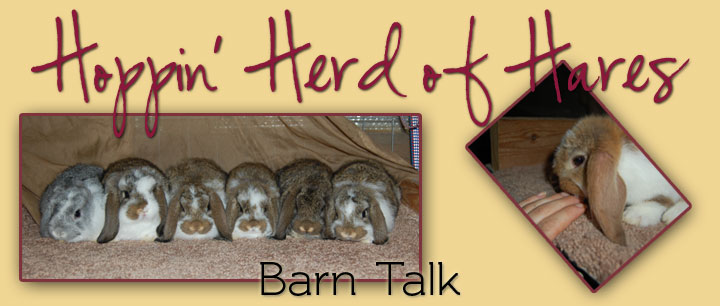Maintaining a herd that is healthy and produces well takes good herd managment and a clean environment. I hope to be able to do a few of these type of posts over the next few days to couple weeks, as I think of topics ;).
~ Herd Health & Managment ~
Good herd managment is a must when you have animals of any kind. At times I think some people may forget about it, because "they're just rabbits." But really, rabbits require just as much knowledge & management as any other farm animal, just on a smaller scale.
There is a lot that goes into keeping a good, quality, healthy herd going.
1. Proper feed is essential. A lot of new rabbit breeders in particular don't realize the problems constantly switching feeds can cause. It can really tweak the rabbits systems out. I found out the hard way once we moved to Oklahoma and I had to find the right feed. You can see some of the feed posts I did last year when I was using a lousy feed, Purina Fibre3, and after I switched at here, here and here. Thankfully it has been almost a year now and my rabbits continue to do wonderful on PenPals.
I did quite a detailed post about feed last summer and you can find that at "What Feed to Use?"
2. Adequate housing, clean conditions and proper ventilation are also extremely important. Cages that are too small for the particular breed or size of rabbit can cause a lot of problems.
Mini lops need to be in cages no smaller than 24”x24”. And that is only for does without litters and bucks. If the doe is raising a litter, she needs to be in a 30”x30, 30”x36” or at the smallest a 24”x30.
If the mini lops are in cages any smaller, they will be very cramped and not able to move, stretch out & run around like they need to be able to.
Years ago I once picked up some New Zealands from a person who had them in very tiny cages. Had to be 15x24” or 18”x24 at the most. They were tiny! Those rabbits could not fully extend their back legs when they were in a large pen because they had been grown & raised in those tiny cages and never able to stretch out. Mini lops are a bit smaller than a New Zealand, but the above sizes are still way too small for them.
The smaller cage sizes can be fine for some of the smaller breeds that are only 2-3 lbs. But, even bigger cages would be needed for the large breeds like the meat breeds or even French Lops, Rhinelanders, Belgian Hare, etc.
The cages should be kept clean, so that the rabbits are not sitting in their own waste. If the wire on the bottom of the cages is let to pile up with fur, droppings and who knows what else, it'll lead to health problems. It's just common sense not to let them sit in their own droppings anyways.
It takes time to make sure your rabbits stay clean, because some rabbits can be messier than others, but it is well worth it. Worth it to have a healthy herd.
When I give the rabbits hay, there are some who seem to always end up pooping on the leftover pile of hay about a day after I give them hay. So, I instantly have to clean it up, otherwise it'll lead to a nasty mess. With babies that mess can happen even quicker, especially if you are someone who likes to give your babies hay every day ;).
Poor ventilation will lead to health problems also. Especially respiratory problems. Rabbits have very sensitive respiratory tracks. The ammonia, fur & dust will accumulate and burn the rabbits' noses.
Ventilation needs can require even more maintenance when it comes to certain times of the year. If you use an air conditioner in the summer, ammonia smell can build up very fast if you do not keep your barn extremely clean. I use ZAPS-IT in the summer to kill ammonia smell & molecules. It works wonders. It makes it so that I can dump the pans every other day, instead of every day. I still rinse the big trays off every day, but I don't have to do it twice a day this way.
Part 2 will come tomorrow, Lord willing :) . . . if I have a moment to blog tomorrow.
Qadoshyah









0 comments:
Post a Comment